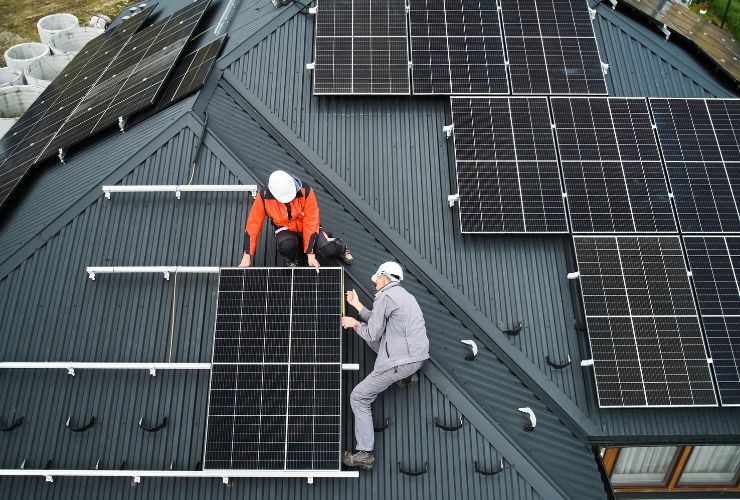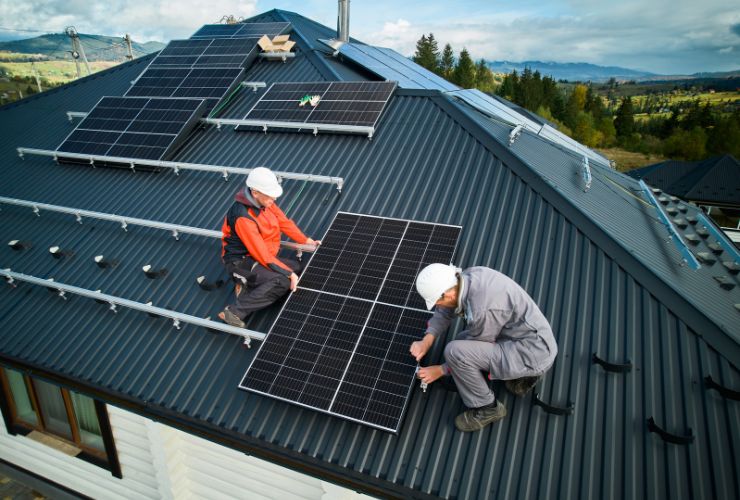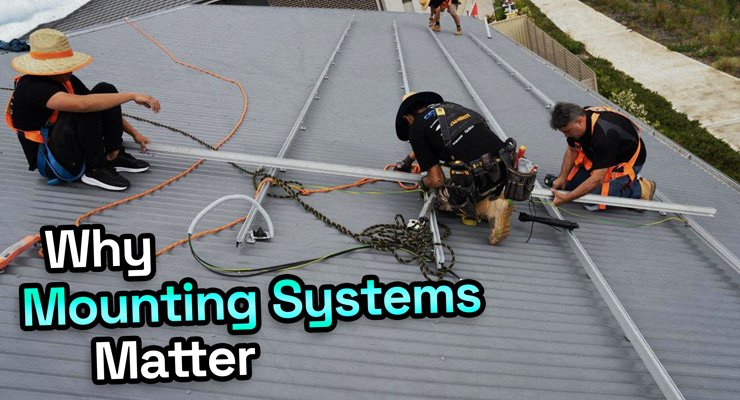Fast read
Selecting the right solar panel mounting frames is crucial for a successful solar energy system. Often overshadowed by the focus on panels and inverters, these frames play a pivotal role in ensuring system stability, efficiency, and durability.
Compliance with standards such as AS/NZ1170.2:2011 and AS/NZS1164.1:1997 is vital, especially in coastal areas where corrosion resistance matters. Considerations include optimizing panel angles and orientation, aesthetics, ensuring structural integrity to withstand weather conditions, and compatibility with your roof type.
While tilt frames can enhance electricity generation, they may limit usable space and add upfront costs. Your choice should align with your specific needs, budget, and roof characteristics.
Choosing the right solar panel mounting for you
When harnessing the power of the sun with solar panels, many homeowners prioritize the solar panels and accompanying inverters. However, one critical aspect that often gets overlooked but should never be underestimated is the solar panel mounting system.
The frames that hold your solar panels in place on the roof are an important part of your solar PV system. They help keep the system stable, efficient, and long-lasting. This guide will explore the rules, considerations, and benefits of choosing the right mounting frames for your solar panels.
The guide will provide detailed information on the rules that need to be followed when selecting mounting frames for solar panels. It will also discuss the important factors that should be taken into account when choosing the mounting frames.
Regulations and standards
To choose the right solar panel mounting frames, it’s important to first understand the regulations and standards that apply to them. Mounting frames must meet specific standards to ensure they can securely hold the panels against high wind forces and other loads throughout their lifespan.
In Australia and New Zealand, several standards apply to solar panel mounting systems, including:
- AS/NZ1170.2:2011 – Wind Loads: This standard defines the wind load requirements that mounting frames must withstand to ensure the panels remain secure in windy conditions.
- AS/NZS1664.1:1997 – Aluminium Structure Design: This standard outlines the design criteria for aluminium structures, which often make up the framing of solar panel mounting systems.
- AS1720, 2010 – Timber Structures: These standards provide guidelines for calculating the fixing capacities of timber roof screws, which are commonly used in solar installations.
- AS/NZS4600:2005 – Cold-Formed Steel Structures: These standards specify the fixing capacities for steel roof screws used in solar panel mounting systems.
It is the responsibility of the installer to ensure that the chosen mounting system complies with these standards. Additionally, if you live in a coastal area, corrosion resistance is essential, and you should verify that the mounting system is treated and warranted for corrosion resistance.

Considerations for choosing the right mounting frames
- Angles and Orientation
The angle and orientation of your solar panels can significantly impact their energy production. Mounting frames allow you to position your panels at the optimal angle and direction to maximise solar energy absorption throughout the day. A properly aligned solar power system produces more energy and operates more efficiently.
You can use different mounting frames to change the tilt and angle of your solar panels. This helps you align them perfectly based on where you are and how much energy you need. By optimising the angle and orientation, you can enhance your solar system’s overall performance.
- Aesthetics
It’s important to consider the appearance of your solar panels, especially if they are visible from the street. It’s also important to take into account any specific architectural guidelines that need to be followed. Some mounting frames are designed to be sleek and low-profile, blending seamlessly with the overall appearance of your solar system.
Choosing aesthetically pleasing mounting frames can help maintain the visual harmony of your property while harnessing solar energy.
- Structural Integrity
Solar panels can be heavy, especially when multiple panels are installed. The mounting frames must be robust enough to support the weight of the panels and endure adverse weather conditions, such as wind, snow, and rain. Selecting strong and durable mounting frames is essential to ensure the structural integrity of your solar system.
- Roofing Style
The type of roof you have is important in deciding which mounting frames are best for your solar panel installation. Ensure that the frames match your roof design. This will allow the panels to be securely fastened without harming the roof’s structure.
Different roofing styles may require specific mounting options, such as flush mounts, ballasted systems, or roof-integrated solutions. Assess your roof type and select the appropriate mounting frames accordingly.
Tilt frames: to tilt or not to tilt?
One common consideration when choosing mounting frames is whether to opt for tilt frames. Tilt frames allow you to angle your solar panels for better sun exposure. However, the decision to use tilt frames should be based on various factors, including roof pitch, available space, and cost-effectiveness.
Benefits of tilt frames:
- Improved Energy Generation: Tilt frames can optimise the generation of your solar panels by angling them to capture more sunlight, particularly during the winter months when the sun is lower in the sky.
- Self-Cleaning: Tilted panels are more effective at self-cleaning when it rains, as the rainwater helps wash away dirt and debris, maintaining higher energy production.
Considerations against tilt frames:
- Reduced Usable Space: Tilt frames may reduce the usable space on your roof, limiting the number of panels you can install. This could result in lower total capacity and energy generation compared to flush-mounted panels on a low-pitch roof.
- Cost: Tilt frames come with additional costs for materials and installation. You should weigh the potential increase in energy generation against the upfront expenses.
In many cases, it may be more prudent to install solar panels flush with a low-pitch roof and increase the number of panels to achieve higher total capacity and energy generation. Your decision should align with your specific energy goals, available roof space, and budget.

So is solar panel mounting important?
Choosing the right mounting frames for your solar panel system is important. This decision impacts the stability, efficiency, and durability of your investment.
The choice you make will affect how well your system performs and how long it lasts.
Make sure to choose the right mounting frames for your solar panel system. By considering factors such as structural integrity, optimal positioning, roof compatibility, aesthetics, and ease of installation and maintenance, you can make an informed choice that ensures the long-term success of your solar energy project.
It is important to work with a reputable installer who understands the regulations and standards for solar panel mounting systems. They can help you choose the best frames for your specific needs. With the right mounting frames in place, you can harness the full potential of solar energy while enhancing your solar system’s visual appeal and longevity.



